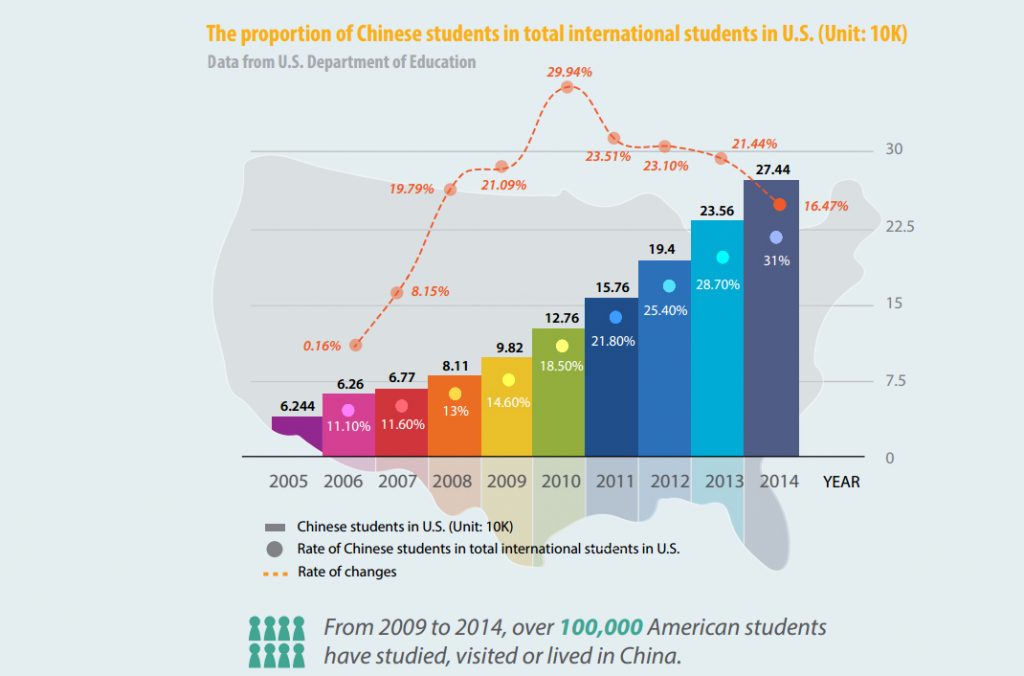The United States and China – arguably the two most powerful nations in the world – held two high-profile government meetings last month: the 7th Annual US-China Consultation on People-to-People Exchange (CPE) and the 8th Annual US-China Strategic and Economic Dialogue (S&ED).

(China-US Focus graphics)
Yet even with the CPE, S&ED and other diplomatic efforts that seek to strengthen the US-China bilateral relationship, tensions remain high over issues of critical importance such as the South China Sea, cybersecurity, nuclear proliferation and climate change.
The US-China relationship is in a precarious place. The strength of its future will require a greater understanding of its people, its history, its language, and its culture.
That’s why we, the US-China Strong Foundation, recently relaunched to address our evolving and expanding mission – and the evolving and expanding complexities of the U.S.-China relationship. Our charge: to strengthen U.S.-China relations by investing in a new generation of leaders who have the knowledge and skills to engage with China.
Previously known as the 100,000 Strong Foundation, US-China Strong seeks to grow the number and diversity of U.S. students studying in China; increase to 1 million the number of US K-12 students learning Mandarin by 2020; and develop a network of young American and Chinese adults to share connections and friendships, and pursue professional development opportunities.
The importance of American and Chinese cross-cultural understanding cannot be understated. We must prepare the next generation – our future leaders – to manage this relationship smartly and effectively.
The numbers alone underscore this need. The United States and China are economic heavyweights – the two largest economies in the world — earning GDP of $17.4 trillion and $10.3 trillion in 2014, respectively. Combined, at more than $27 trillion, this far and away exceeds the combined GDP of Japan, Germany, Brazil, India and more. Two-way trade between the United States and China reached nearly $600 billion in 2014, and China is America’s fastest growing trade partner. American and Chinese business people and consumers must be able to understand each other’s markets and ways of life.
Militarily, the United States and China have two of the world’s largest defense budgets. Disputes have escalated as China seeks to assert its dominance in the South China Sea while the United States and its allies try to protect the region’s sea lanes of control. In the same vein, the United States and China continue to clash on issues related to cyber security. Progress has been made, but mutual distrust in this area remains dangerously high. To arrive on common ground – to find a solution to the South China Sea and to cyber security issues – it will be imperative for future American and Chinese leaders to cooperate, communicate and negotiate effectively.
Meanwhile, the United States and China have made remarkable progress on steps to address climate change, with both signing the United Nations Paris Agreement in April – a fundamental step given that the two nations lead the world in carbon emissions. Similarly, as two of the five permanent members of the UN Security Council, both countries must work together to manage and prevent nuclear proliferation. This is particularly noteworthy given America and China’s involvement in the Iran deal, and both countries’ various interests with regard to North Korea.
These issues and more speak to why US-China Strong and its mission are so important. It begins with our young people – Americans must have a greater appreciation for and an understanding of their Chinese counterparts.
In 2014, more than 300,000 Chinese students were enrolled in colleges and universities here in the U.S. While on the rise, only approximately 25,000 American college students studied in China that same year. According to the International Institute of Education, China is the top country of origin for students coming to the US for the sixth consecutive year, with Chinese students comprising more than 31 percent of international students studying in the US.
What’s more, the number of American K-12 students learning Mandarin pales in comparison to their Chinese counterparts who are learning English: just 200,000 Americans compared to more than 300 million Chinese. English is mandatory part of the Chinese K-12 curriculum, while languages are being squeezed out of the American public school system.
The US and China have tremendous potential to create a more productive, stronger relationship – one that must start with our youngest learning Mandarin and stretch through study abroad to China, and culminate with our young professionals entering China-focused careers.
Cooperation and engagement at all levels will undoubtedly bring our two countries closer together. It will undoubtedly allow us to work better together to solve our world’s most pressing challenges.
